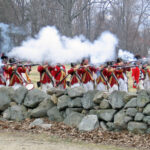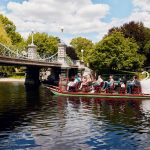Cold Rush | A White Mountains Ice-Climbing Adventure
When it comes to ice climbing in the Mount Washington Valley, nothing is predictable except the urge to keep coming back.
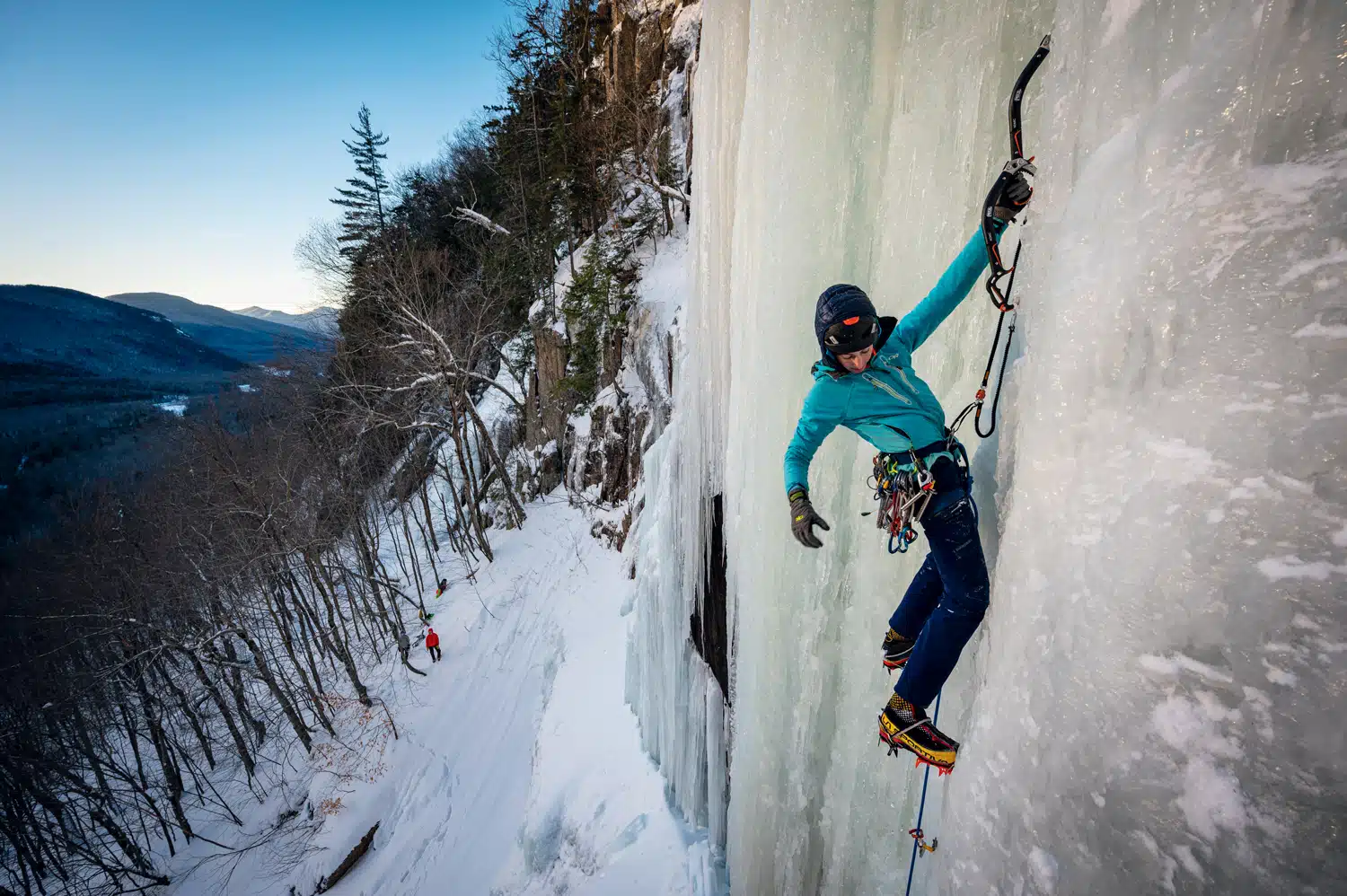
Coffee By Design | Portland, Maine
Photo Credit : Katherine KeenanBy Michael Wejchert
Dusk is hunting us down, the way it stalks everybody in northern New England this time of year. It’s January and my wife, Alexa, and I are halfway up Remission, an ice climb on Cathedral Ledge outside North Conway, New Hampshire. And we are racing the dark.
The new ice I swing into has formed practically overnight, sticking in blobs to Cathedral’s cold granite. Toeing in with my crampons, scratching for the perfect placement in the thickest bit of ice, I concentrate on breathing and relaxing. I forget that my legs are sore and that I am fighting a vicious cold. Move up. Test the ice. Retreat to a stance. Move up again. Repeat. Each placement of an ax takes me that much higher.
I clip myself to the first belay stance, begin yarding up rope, and stare out toward town as Alexa climbs up behind me. The last sunlight burnishes the fields of North Conway and glints against the Saco River, which weaves its way south in a lazy midwinter slither among patches of ice. Lights start to flicker on downtown, bright and clear in the frigid air.
From their houses at the base of Cathedral, a few people must be watching our headlamps blinking on. They must be wondering what we are doing dangling from a piece of ice halfway up a cliff on so cold an evening. After 20 years of winter climbing, I often wonder, too. But once in a while, everything comes together: a climb caught at the right time; a fleeting feeling of poise, gone as quickly as the ice on a warm day. Fragments of moments, caught in the margins of our darkest season. They feel worth it.
Below me, Alexa finds the thickest part of the thin ice to swing into. The pick of her ax sinks in with a thud as she works her way up the tongue of frozen water. We’ve both climbed Remission more times than we can remember, even though this hourglass-shaped route usually plasters itself to our home cliff only once a year. Yet each time seems to require something new or different, so we keep coming back.
It’s cold, but water still drips all around me, splashing my jacket, my climbing boots. In the dying light, with the sun no longer melting snow from above, the flow of water freezes and pastes itself to the cliff. I can see it happening, and I wonder if we’re here at just the right time or if we are early, if the ice will be thicker and better in a day or two. So much relies on knowing conditions, on trying again and again, and on being ready and available and prepared when it all comes together.
When Alexa and I met, we both worked as winter climbing guides in between gigs banging nails and babysitting, the kinds of jobs young climbers fill their schedules with to make ends meet. Alexa is an ER nurse now, and I write books and magazine articles. The need to climb doesn’t boil over like it used to; I no longer force it when everything doesn’t line up. But sometimes we still push our limits.
On this January day, we’ve been up since 4 a.m., on standby along with other Mountain Rescue Service volunteers to try to bring a deceased hiker out of the mountains an hour north of town. All morning, we were clunking our boots together at the trailhead to stay warm as radios crackled and exhaust plumes shot out of Fish and Game trucks. Although the weather cleared enough for a helicopter to land at the scene and we were called off after hiking just three miles, it’s already been a rough day.
On impulse, I drove us toward the Cathedral parking lot instead of going straight home. With last night’s cold, Repentance and Remission—twin ice climbs that are considered among the best winter routes in the lower 48—have formed, gleaming on the cliff like two strings of pearls. Seeing this, we nodded, then drove the eight minutes back to the house, where we tossed ice screws, axes, and crampons into our packs before being briefly tempted to collapse on the couch. Soon I was up the first pitch, focused entirely on what’s in front of me, exactly what I needed.
While Cathedral isn’t Alaska—there’s a hospital nearby and routes are 300 feet, not 3,000—the climbs demand the same attention. It’s why many of the best winter climbers in the country live in New England. All our little climbs add up to big ones in other mountain ranges. And sometimes the backyard feels just as precarious.
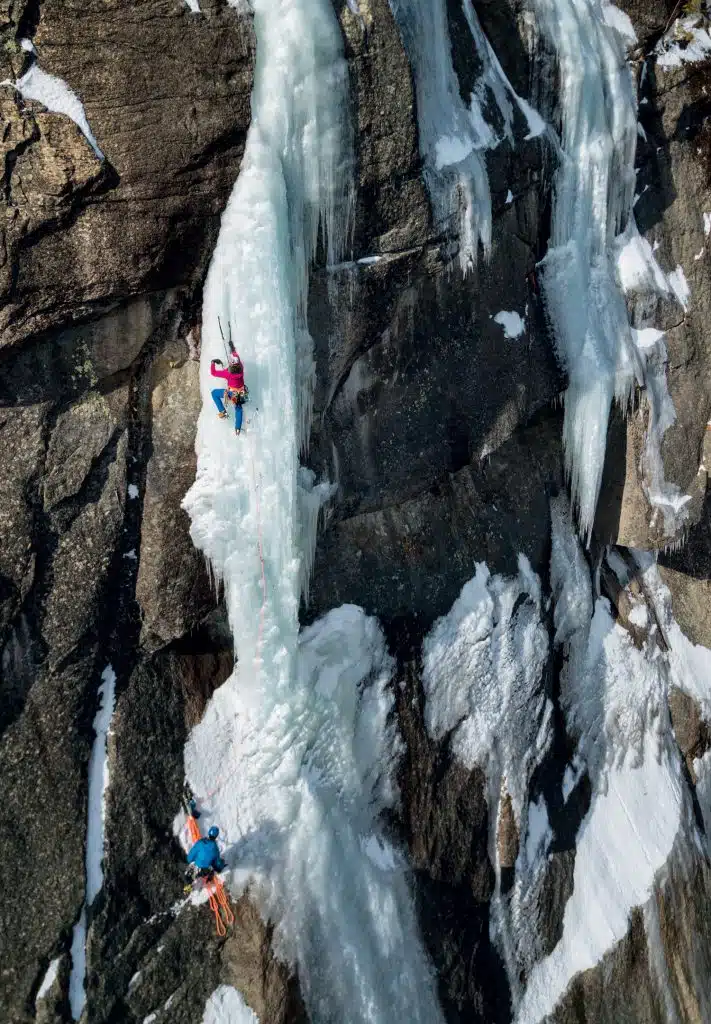
Photo Credit : Joe Klementovich
Last time I climbed Remission, a chunk of ice reacted to a swing of my ax, exploding off the wall before slamming into my face. Blood spouted onto my jacket; I fought to keep from falling. I shook my head a few times, punch-drunk. My broken nose ballooned so much it took days before it could be set into place again. Last winter, a young climber started up Repentance on a day when the temperature was above freezing, and his ax sheared through the ice like a spoon scooping ice cream from a pint left on the counter too long. It was a costly error in judgment: He fell 20 to 30 feet before being caught by his climbing partner and suffered a compound leg fracture.
The sun is nearly gone. We’ve been driving or hiking or climbing for hours. I want hot soup. I want our couch, the woodstove, to crawl into bed. But a steep pillar of ice, Remission’s crux, glistens above me. The gathering darkness renders the familiar climb an unknown, and those are the best climbs, when the dance between success and failure is far from choreographed. The pillar is wet and still forming and I am not sure I have the skill and stamina to climb it in the dark—at least not safely, anyway—but when the conditions are this good, there’s always that lick of fire in the back of my brain telling me to keep going up.
* * * * *
I grew up in southern New England but my parents met in New Hampshire, where they taught at Brewster Academy, a boarding school skirting Lake Winnipesaukee, before moving to western Massachusetts and then Connecticut. My father climbed ice. In high school, my feet finally big enough to fit into a pair of his ancient leather mountaineering boots, we’d drive north to stay with the friends he’d climbed with before I was born; rising in darkness, we made our way up the routes my dad had done as a student at the University of Maine or as a teacher in New Hampshire. He would tiptoe on the front points of his crampons, his profile framed by the foul weather of New Hampshire’s notches. I had not thought of him as graceful before. But in that balance—his calves straining, the rope stretching down beneath him—I saw him in a different light.
Sitting on a bunk bed at the base of Mount Washington or driving south in the Sunday darkness to make it back to school on time, I’d flip through the guidebook of New England ice climbs. It was loaded with photos and descriptions of routes with mythic names like Valhalla and Ragnarock. I’d stare at climbers tapping their way up impossible-looking tendrils of ice that froze to cliffs only when clouds and cold conspired together long enough; that offered safe passage for a few days or even hours; that had been climbed only a handful of times. New England crags seemed full of climbs like that. They felt different from the big mountains and the huge cliffs of the West. They promised a sheltered kind of mystery for anyone willing to check out the next cluster of birch trees or the fork in a logging road or the tight contour lines on a map. The idea of spending a lifetime developing the skill and strength to ascend these climbs burrowed into my head early.
I left New England to go to college in Colorado, where the mountains were higher and there was far more climbing. Returning back east after not finding work, I moved into a cheap rental in the White Mountains. Taping a list of routes to the fridge, I figured I’d need a single winter to climb the classic ice lines before I fled back west to chase bigger goals. That was 16 years ago.
* * * * *
If the compact universe of New England ice climbing has a hometown, it is North Conway, and International Mountain Equipment is its epicenter. There, Rick Wilcox, the de facto guru of New England climbing who has owned the store since 1979, holds court.
Ice climbing as we know it goes back just a half century—a faded notebook behind the counter at IME still acts as the official record for first ascents in the Mount Washington Valley. Take a walk upstairs and you’ll migrate away from shiny $400 carbon fiber axes for sale and toward a display case holding the boots Rick wore to climb Everest “before it was crowded” and the bamboo ice axes he and his partner used on the first ascent of Repentance, when ice climbing was more garage science than anything else.
Until the late ’60s, climbers mostly worked their way up snow and ice only when they needed to, on big alpine faces, almost always carrying just one long ax to chop steps into the ice. The process was exhausting, and the icy parts of a climb were often the most time-consuming and tiring. That all changed in 1969, when a young Californian named Yvon Chouinard (who in a few years would found a small clothing company he called Patagonia) invited a small cadre of northeastern climbers to an “unusual educational experience,” as historians Laura and Guy Waterman put it, in the Adirondacks. There, he demonstrated a radical ice ax, shorter and more aggressive, that could be paired with a second ax to climb in a new way: by facing inward and moving up steep ice previously thought impassible. Literally overnight, the hundreds of ice formations within view of anyone driving through New Hampshire’s Crawford Notch or past Vermont’s Lake Willoughby became possible to climb, and Rick and a handful of buddies raced to pick the choicest plums. Nowhere else in the United States was there so much ice so close to the road.
Better ice axes and crampons meant a quantum leap in possibility, though the gear was still far from reliable by modern standards. Routes like Remission took all day and equipment often broke (Chouinard’s axes had bamboo handles). But as word got out and the gear improved, North Conway became a destination for thousands of visiting climbers.
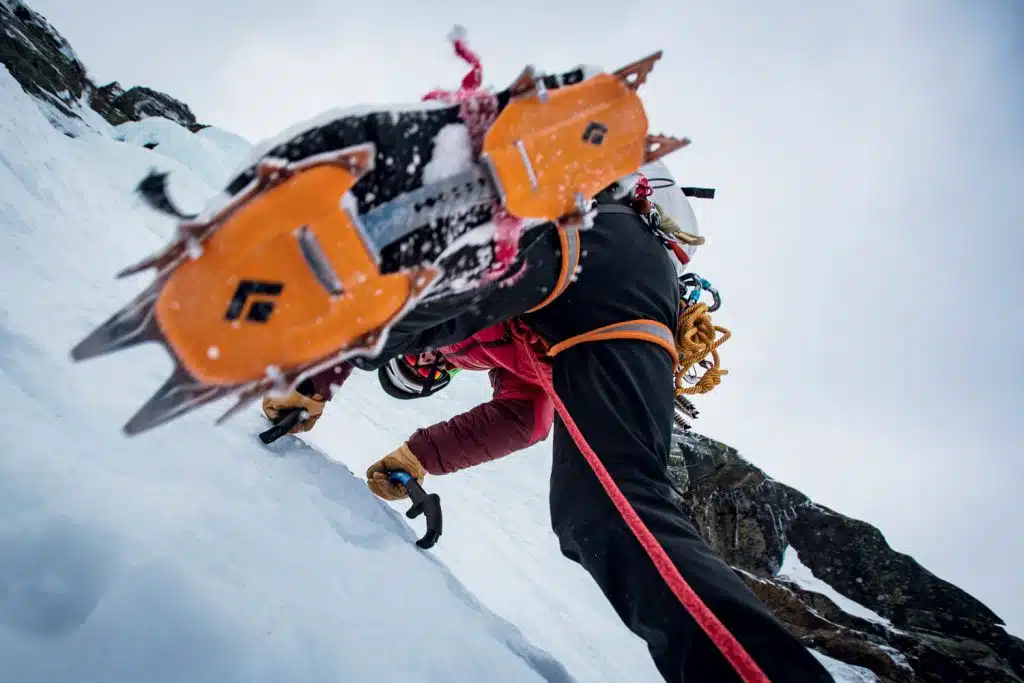
Photo Credit : Joe Klementovich
To climb here on the same routes that Rick and others worked their way up five decades ago is to take on the “burden of history,” as one older mentor puts it, and each generation strives to add routes thought impossible by the last in order to cement their own reputations. The new climbs are thinner, sickly-looking pencils of ice tucked back in the woods or deemed too difficult by the sport’s pioneers. Every once in a while, a freak storm causes a dribble of ice to freeze in a place no one’s ever seen before. These climbs form rarely, sometimes just once a decade, sometimes just once—period. But the promise of it all has kept me and a host of others in town, kept our axes sharp, our eyes glued to the forecast, hoping for something remarkable to freeze just long enough to climb.
If you stay in town, undergoing the metamorphosis from itinerant climbing bum to full-fledged functioning member of the community, chances are Rick has hired you as a guide or a shop employee, loaned you money for gas, helped you set up a slideshow to pay for your next climbing trip, or replaced the brakes and rotors on your abused climbing jalopy (free of charge, of course). Other climbing stars may have burned as brightly on rock and ice, but no one has galvanized this teeny community like Rick, who still occasionally finds time to get out and do the thing that’s kept him around all these years.
As the years passed, I stopped traveling to climb as much, which meant tuning into the nuances of what was happening back home more. Alexa and I married, went back to school, got jobs. We stopped being able to fit everything we owned into the backs of our cars. We stayed in part for the promise of those rare winter climbs, but mostly for the friends who climbed them, and now it’s impossible to think about leaving. Ice climbing—such a fickle thing—remained a constant force in our lives. We’re not alone in this.
Driving back home through Crawford Notch one day last winter, I spotted a familiar mustachioed figure schlepping his climbing pack to the parking lot: Rick Wilcox, heading back from another day on the ice.
* * * * *
On the next pitch of Remission, the delicate climbing draws me in right away. It’s thinner than I’ve ever climbed it before, and each move takes an eon to parse: if the tenuous bond will hold or not, or if my ice ax will just sail through and ping off the rock beneath. The climb spills over a bulge where the steepness eases up and the ice becomes thicker up there. After 20 feet, I twist in an ice screw I know will actually hold.
“That one’s good,” I tell Alexa, and she lets out a sigh of relief. But this is usually the easy bit, and it’s still taking forever to tack my way upward. The pillar looks slimmer and less probable the closer I get to it. I ascend another 30 feet or so, right below the pillar, clip myself into an anchor halfway up the cliff, and put Alexa on belay. I stare up toward the next pitch.
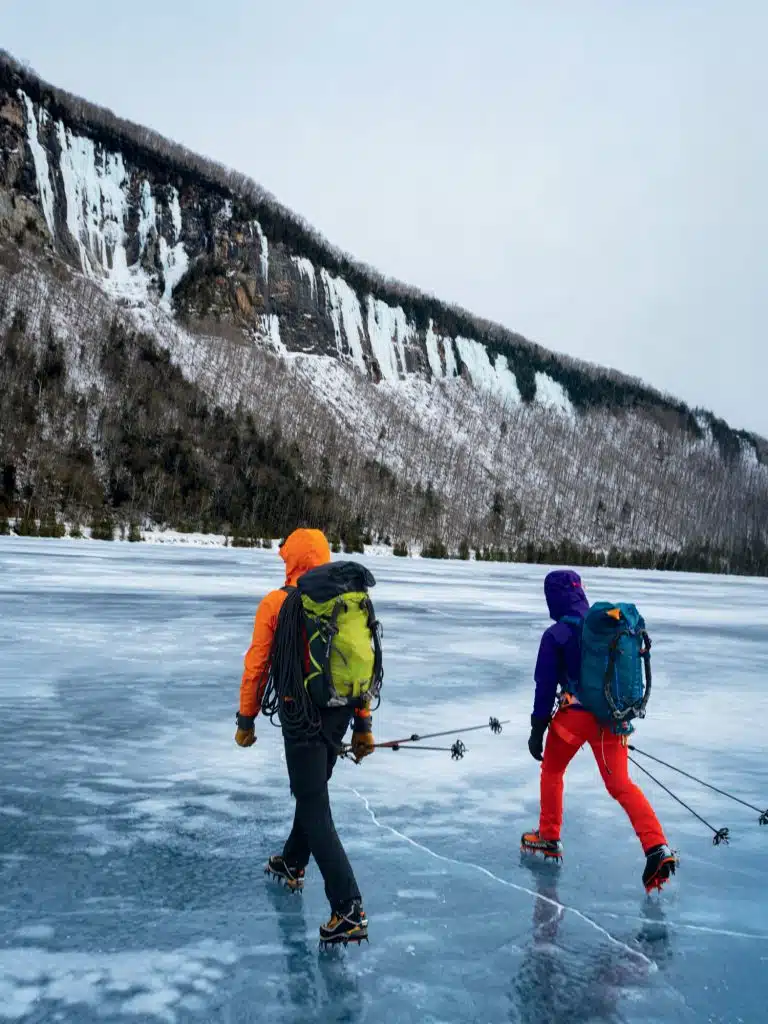
Photo Credit : Joe Klementovich
These past few years, it’s been too warm for Remission to grow truly fat; the melt-and-freeze cycle on which the climb relies is mostly melt these days. The climb has changed with the climate. A dagger of ice dangles in the middle of its upper chimney, a tricky prospect to get around. It’s a new development. A downed tree in a different place, a divergence in a stream, a wedged rock coming loose in a chimney—these things can alter where water flows and how a climb forms.
After I reach the anchor, Alexa climbs up toward me. The woods and the neighborhood settle into a pastoral silence. A barred owl glides into a crook of spruce tree before its mottled brown feathers dissolve into bark, perfectly camouflaged by its stillness. Some climber friends eager to scope out conditions stroll the path below us with their dog, watching for a few minutes before continuing onward. The woods darken below. The column of ice glows as my world shrinks, framed in the confines of my headlamp beam. The fire dies down in my head, extinguished by the darkness, by reality crashing in.
“What do you want to do?” Alexa asks me. She already knows the answer.
“I think we should bail,” I say, staring up at the pillar.
In the blackness we slide down our rope to the ground and pull it until it slithers into a heap at our feet.
“Maybe we can come back tomorrow before work,” I offer hopefully, but we both know our bodies are spent. We stumble through the woods the few hundred meters to the car, toss our gear into the trunk, and drive home, back to the woodstove, to dinner, back to blanketing ourselves in creature comforts.
Remission hangs in there for just six more days. Two teams of climbers scratch their way to the top; a few parties try and fail. Then it warms up and the climb falls apart again, parts of the pillar crashing into the woods, parts of the climb simply turning to water and dripping, drop by drop, down the cliff.
Ice climbers call those days when they don’t really climb much “taking the gear for a walk.” Those are my favorite days in New England now: sauntering over to the cliff to see if any new ice has formed, free of any timeline or expectation and ready to be surprised. The burn of cold, of chasing something ephemeral and absurd and a little dangerous with close friends or even loved ones.
Sometimes that’s all it ends up being: a shadow of a climb, a ghost in the woods that’s here one hour and gone the next. It’s hard to tell without going, though. Testing the ice to see if it will hold, retreating when it does not. Sometimes you get lucky. Sometimes not. Sometimes—on the best days—you start up for the sake of starting up.
The author pushes toward the top in Dixville Notch, New Hampshire.

